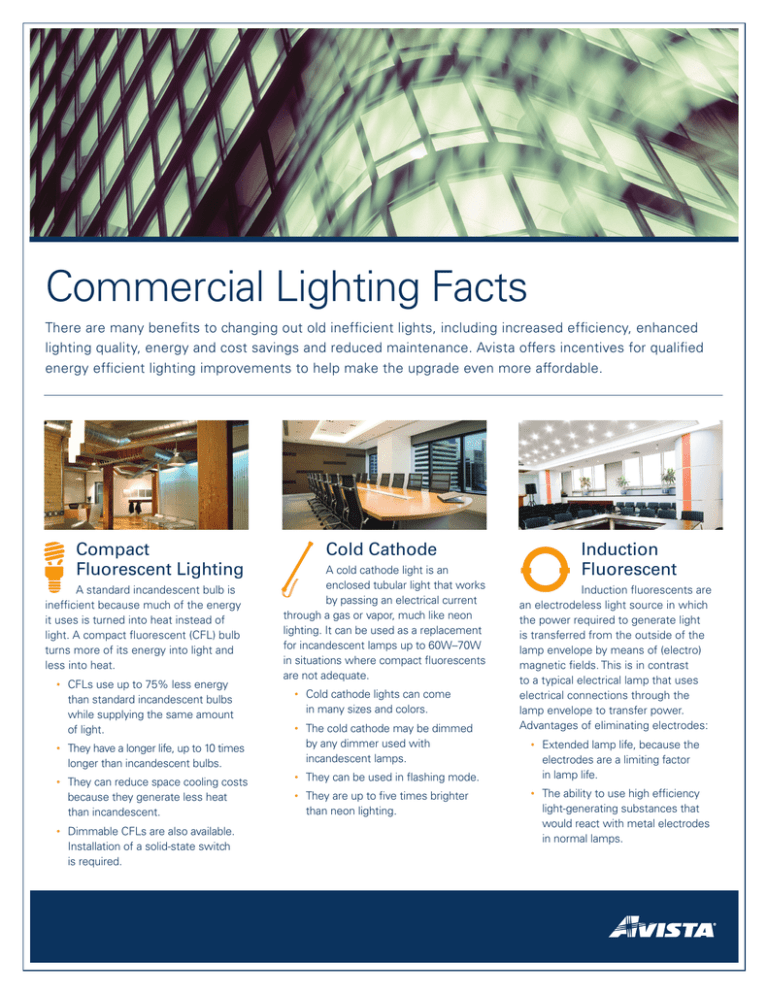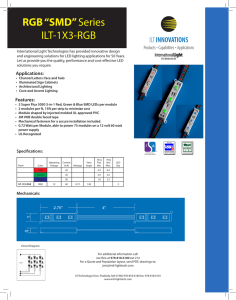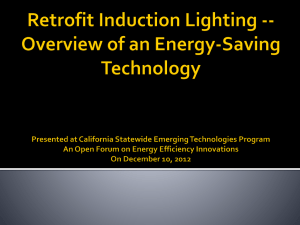Commercial Lighting Facts
advertisement

Commercial Lighting Facts There are many benefits to changing out old inefficient lights, including increased efficiency, enhanced lighting quality, energy and cost savings and reduced maintenance. Avista offers incentives for qualified energy efficient lighting improvements to help make the upgrade even more affordable. Compact Fluorescent Lighting A standard incandescent bulb is inefficient because much of the energy it uses is turned into heat instead of light. A compact fluorescent (CFL) bulb turns more of its energy into light and less into heat. • CFLs use up to 75% less energy than standard incandescent bulbs while supplying the same amount of light. • They have a longer life, up to 10 times longer than incandescent bulbs. • They can reduce space cooling costs because they generate less heat than incandescent. • Dimmable CFLs are also available. Installation of a solid-state switch is required. Cold Cathode A cold cathode light is an enclosed tubular light that works by passing an electrical current through a gas or vapor, much like neon lighting. It can be used as a replacement for incandescent lamps up to 60W–70W in situations where compact fluorescents are not adequate. • Cold cathode lights can come in many sizes and colors. • The cold cathode may be dimmed by any dimmer used with incandescent lamps. • They can be used in flashing mode. • They are up to five times brighter than neon lighting. Induction Fluorescent Induction fluorescents are an electrodeless light source in which the power required to generate light is transferred from the outside of the lamp envelope by means of (electro) magnetic fields. This is in contrast to a typical electrical lamp that uses electrical connections through the lamp envelope to transfer power. Advantages of eliminating electrodes: • Extended lamp life, because the electrodes are a limiting factor in lamp life. • The ability to use high efficiency light-generating substances that would react with metal electrodes in normal lamps. Energy and Cost Savings Digital High Intensity Discharge (HID) Fixtures LED Lighting Light Emitting Diodes (LEDs) produce more light per watt than incandescent bulbs in some directional lighting applications like exit signs and traffic signal lights. LEDs are ideal for use in applications that are subject to frequent on-off cycling and where pure colors are required. LEDs producing area or task light are now competing with other efficient sources and may be used in some applications. Look for the ENERGY STAR® designation on LED products and IES LM-79 & LM-80 testing reports for products producing white light. • Exit Signs have an excellent potential for energy savings, as they are illuminated 24 hours a day, 365 days a year. Replacing incandescent exit signs with more efficient LED models is also a very inexpensive project. We recommend using ENERGY STAR compliant LED exit signs. HID lighting accounts for 26% of all lighting used globally. Virtually all of this lighting uses simple "core and coil" to drive the lamps. Digital HID's dimmable electronic ballasts reduce power consumption by more than 50% for the same amount of light output over the traditional technologies and extend lamp life significantly. Furthermore, these ballasts can be controlled by building management systems for even greater savings. One of the benefits to changing out old, inefficient lights with more efficient lights is the energy and cost savings that are achieved. Here is an example of potential energy and cost savings when a 400 watt HID is retrofitted with a 250 watt Digital HID: Cost Savings Calculation Use the following formula to calculate dollars saved per year by lighting upgrades: Step 1: Determine watts saved. • Total average watts for a 400 watt HID = 455 • Total average watts for a 250 watt Digital HID = 270 Subtract the existing wattage from the proposed wattage: 455 - 270 = 185 watts saved Step 2: Determine watt hours per year. • High-Bay Lighting this example we will use 4368 hours which is 12 hours per day x 7 days per week x 52 weeks per year.) 185 watts x 4368 hours = There are several options available to replace High Intensity Discharge (HID) lighting. • Ceramic Metal Halide Fluorescent T-5s and High Performance T-8s can provide increased light levels over HID while offering instant-on capabilities, longer life and reduced maintenance costs. Ceramic Metal Halide feature an advanced ceramic arc tube designed to improve light output while significantly reducing energy use. These bulbs provide light similar to sunlight and last longer than traditional HIDs. Fixtures using these lamps are designed for both interior and exterior applications. For questions regarding the Commercial Lighting Program please call your account executive or Camille Martin, 509-495-4276. 1/13 Multiply the watts saved by the hours of operation: (For 808,080 watts per year Step 3: Convert watts hours to kilowatt-hours (kWh). • Divide watt hours per year by 1000: 808,080/1000 = 808.08 Each fixture from this example will save ~808 kWhs per year. (Savings from cooling not included.) Result: Determine cost savings per year. • Multiply the kWh savings by the energy cost: 808 x $0.10 (cents per kWh will vary per rate schedule) = $81 in energy cost savings per fixture per year.


